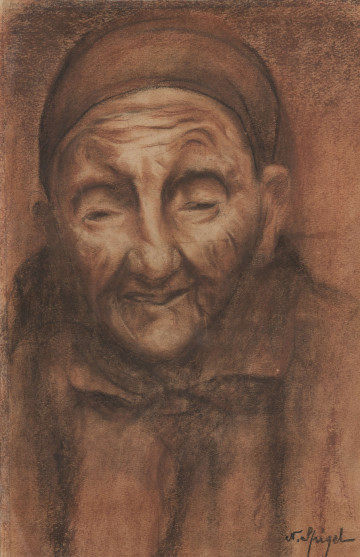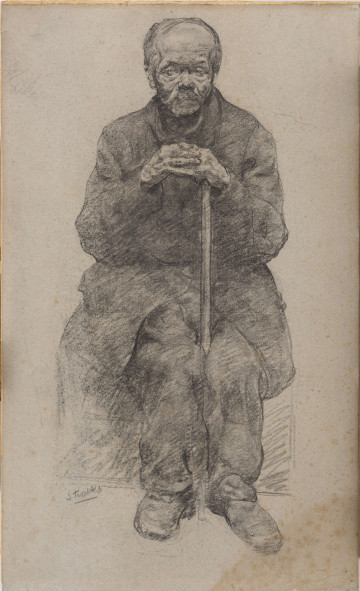
Janusz Kossakowski and Wincenty Herbst
1863
National Museum in Lublin
Part of the collection: European classics of modernity
The portrait presents an elderly woman with subtle features and an expressive, gentle look; she is shown against a solid dark grey and green background, sitting on a chair next to a small table. The woman is wearing a dark violet dress, with a small ruff at the collar and cuffs finished with white lace. The woman’s head is decorated with a small black bonnet made of lace. The table on the right hand-side with glasses and a vase with red geraniums subtly emphasises the intimate nature of the scene, building atmosphere of domesticity. This is the way in which Hugo Crola presented Louisa Brumm (1820-1906), the wife of Ferdinand Brumm (1816-1885), a chairman of the Pomeranian merchants’ association, one of the founders and a long-term chairman of the supervisory board of the Vulcan shipbuilding company, a co-founder of the Prussian Insurance Society. The Brumm spouses, who lived at the present-day Mariacka Street in Szczecin, were some of the most respected city dwellers, even though they never became famous for being patrons of the arts, in contrast to the Dohrn or the Quistorp families. Hugo Crola immortalised the image of the wife of the Szczecin industrialist by perceptively revealing psychological characteristics of the model: such traits as modesty, restraint and attachment to tradition are highlighted. The portrait is a good example of the German art in the 4th quarter of the 19th century: the time of bourgeoisie affluence, when the old Biedermeier ideals remained valid. The mode of using the light and the finishing of the surface with a subtle glaze testify to the artist’s craft. The portrait, even though made with infinite precision and care, retains its natural lightness and ease.
Dariusz Kacprzak
Author / creator
Dimensions
cały obiekt: height: 115 cm, width: 87 cm
Object type
painting
Creation time / dating
Creation / finding place
Identification number
Location / status

1863
National Museum in Lublin

1932
National Museum in Lublin

1801 — 1850
National Museum in Lublin
DISCOVER this TOPIC
Castle Museum in Łańcut
DISCOVER this PATH
Educational path